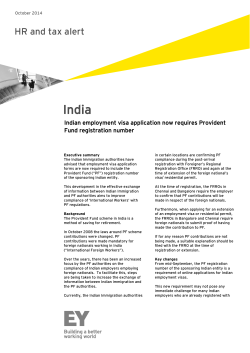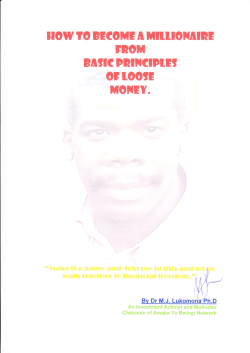
इंटरनेट मानक Disclosure to Promote the Right To Information
इंटरनेट
मानक
Disclosure to Promote the Right To Information
Whereas the Parliament of India has set out to provide a practical regime of right to
information for citizens to secure access to information under the control of public authorities,
in order to promote transparency and accountability in the working of every public authority,
and whereas the attached publication of the Bureau of Indian Standards is of particular interest
to the public, particularly disadvantaged communities and those engaged in the pursuit of
education and knowledge, the attached public safety standard is made available to promote the
timely dissemination of this information in an accurate manner to the public.
“जान1 का अ+धकार, जी1 का अ+धकार”
“प0रा1 को छोड न' 5 तरफ”
“The Right to Information, The Right to Live”
“Step Out From the Old to the New”
Mazdoor Kisan Shakti Sangathan
Jawaharlal Nehru
IS 13852 (1994): Tea - Preparation of ground sample of
known dry matter content [FAD 6: Stimulant Foods]
“!ान $ एक न' भारत का +नम-ण”
Satyanarayan Gangaram Pitroda
“Invent a New India Using Knowledge”
“!ान एक ऐसा खजाना > जो कभी च0राया नहB जा सकता ह”
है”
ह
Bhartṛhari—Nītiśatakam
“Knowledge is such a treasure which cannot be stolen”
.
IS 13852
: 1994
IS0 1572 : 1980
( Reaffirmed 1999 )
Indian Standard
TEA - PREPARATION OF GROUND SAMPLE
OF KNOWN DRY MATTER CONTENT
UDC
663’95
: 620’113
@I BIS 1994
BUREAU
MANAK
OF
BHAVAN,
INDIAN
9
BAHADUR
NEW DELHI
February
1994
STANDA-RDS
SHAH
ZAFAR
MARG
110002
Price Group
1
Stimulant
Foods
NATIONAL
Sectional
Committee,
FAD 23
FOREWORD
This Indian
Standard which is identical
with
IS0 1572 : 1980
‘Tea - Preparation
of ground
sample of known dry matter content’ issued by the International
Organization
for Standardization
( IS0 ) was adopted by the Bureau of Indian
Standards on the recommendation
of the Stimulant Foods Sectional Committee
( FAD 23 ), and approval of the Fo3d and Agriculture
Division
Council.
In the adopted standard certain terminology
and
in Indian Standards;
attention
is drawn specially
a) Wherever
the words
‘International
should be read as ‘Indian Standard’;
b) Comma
practice
conventions
are not identical
to the following
:
Standard’
and
appear,
( , ) has been used as a decimal
marker, while
is to use point ( . ) as the decimal marker.
referring
in
with
those used
to this standard,
Indian
Standard
they
the current
CROSS REFERENCES
In this adopted standard,
reference appears to certain
International
Standards
for which fndian
Standards also exist.
The corresponding
Indian Standards which are to be substituted
in their
place are listed below along with their degree of equivalence
for the editions indicated:
International
Standard
Indian
IS0 565 : 1990, Test sieves - Metal
wire cloth,
perforated
metal plate
and electro-formed
sheet - Nominal sizes of openings
IS 460
sieves
Part 1
Part 2
IS0
IS 3611 : 1975
Method
ing for tea ( first revision
1839
: 1980
: 1985
Standard
Degree of
Correspondence
Specification
for test
Technically
:
Wire cloth test sieves
Perforated plate test sieves
of
)
sampl-
equivalent
Technically
equivalent
In reporting the result of a test or analysis made in accordance
with the standard,
if the
observed
or calculated,
is to be rounded off,
it shall be done
in accordance
value,
IS 2 : 1960 ‘Rules for rounding off numerical values ( revised )‘.
finaT
with
IS 13852 : 1994
IS0 1572 : 1980
fndian
Standard
TEA - PREPARATION OF GROUND SAMPLE
OFF KNOWN DRY MATTER CONTENT
1 Scope
5.3 Weighing
lid.
and field of application
This International Standard specifies a method
of preparing a ground sample of tea and of
determining its dry matter content, for use in
analytical
determinations which
require the
results to be expressed on the dry basis.
2 References
IS0
1839,
Tea --
Woven metal
Nominal
wire cloth
sizes of
squat form, with airtight
5.4 Constant-temperature
being controlled at 103 f
5.5 Desiccator,
desiccant.
5.6 Analytica-I
IS0 565, Test sieves and
perforated
plate
apertures.
bottle,
oven,
2°C.
containing
an
efficient
balance
6 Sampling
Sample the tea in accordance with IS0 1839.
7 Preparation
Sampling.
3 Definition
For the pupose of this International
the following definition applies:
Standard,
dry matter : The matter remaining
when a
ground sample of the product is heated to
constant mass under the conditions specified.
4 Principle
Grinding of the sample, and determination of
the dry matter content of the ground sample by
heating a test portion in an oven at 103 rt 2°C
to constant mass.
5 Apparatus
of ground
sarllple
Using the grinding mill ‘( 5.1 ), grind a small
quantity of the sample and reject it, then quickly grind an amount slightly greater than that
required for the specified tests and for the
determination of dry matter content.
If the moisture content is too high for satisfactory grinding
of the sample to the fineness
specified in 5.1, it is necessary to pre-dry a
portion of the sample to be ground, in an oven
to a sufficient degree of dryness.
Carry out
the grinding after the pre-dried
sample has
been allowed to cool.
Transfer the grindings to the previously
dried
sample container ( 5.2 ) and immediately close
the latter.
Usual laboratory
apparatus not
specified, and the following items:
o~therwise
8 Determination
of dry matter
of ground sample
5.1 Grinding
mill.
characteristics:
having
followjng
8.1 Preparation
- made of material
moisture;
which
- easy to clean and
space as possible;
capable of
the
as
little
dead
- adjusted so as to produce particles which
will pass completely through a sieve of aperture
size 500 pm ( see IS0 565 ).
5.2 Sample container,
clean, dry, airtight,
made of glass or other suitable material which
has no action on the sample and of such a size
that it will be nearly completely filled by the
ground sampl_e.
bottle
Remove the lid from the weighing bottle ( 5.3 )
and heat both for 1 h in the oven ( 5.4 ) at
Cool in the desiccator
( 5.5 ).
103 f 2°C.
After cooling,
fit the lid and weigh to the
nearest 0.001 g.
does not absorb
having
of weighing
content
8.2 Test portion
Weigh, to the nearest 0,001 g, about 5 g of the
sample in the prepared weighing
ground
bottle ( 8.1 ).
8.3 Determination
Heat the weighing bottle and contents, with
the lid removed but alongside the bottle, in the
1
IS 13852 : 1994
IS0
1572 : 1980
oven ( 5.4 ) at 103 f 2°C for 6 h. Cool in
the desiccator ( 5.5 1, fit the lid and weigh.
Return the bottle and its lid to the oven and
heat again for 1 h, cool in the desiccator, fit
the lid, and weigh, repeating these operations
if necessary, until the difference between two
successive weighings does not exceed 0,005 g.
8.4
Number
mlX
8.5 Note on drying
on the
procedure
In general, a single 16 h period in the oven at
103 f 2°C gives equivalent
results, but it is
the responsibility of the analyst to confirm this
in each particular case.
8.6 Expression
Method
The dry matter
of results
of calculation
content
and formula
of the ground
sample,
by mass, is
i!!Z!Y!
m0
where
m0
is the initial mass, in grams, of the test
portion;
ml
is the mass, in grams, of the dried test
portion.
of determinations
Carry out two separate determinations
same ground sample ( clause 7 1.
8.6.1
RS, expressed as a percentage
given by the formula
Take as the result the arithmetic mean of the
two determinations, provided that the requirement for repeatability ( see 8.6.2 ) is satisfied.
8.6.2
Repeatability
The difference between the results of two
determinations, carried out simultaneously
or
in rapid succession by the same analyst, shall
not exceed 0,3 g of dry matter per 100 g of
sample.
2
Bureau of Indian Standards
BIS is a statutory
institution established under the Bureau of Indian; Standards Act,
promote harmonious development
of the activities
of stadardization,
marking and
certification of goods and attending to connected matters in the country.
1986 to
quality
Copyright
BIS has the copyright of al~l its publications.
No part of these publications may be reproduced
in any form without the prior permission in writing of BIS. This does not preclude the free use,
in the course of implementing the standard, of necessary details, such as symbols and sizes, type
or grade designations.
Enquiries
relating
to copyright be addressed
to the Director
( Publications ), BIS.
Revision of Indian Standards
Amendments are issued to standards as the need arises on the basis of comments.
Standards
are also reviewed periodically;
a standard along with amendments is reaffirmed when such review
indicates that no changes are needed; if the review indicates that changes are needed, it is taken
Users of Indian Standards should ascertain that they are in possession of the
up for revision.
latest amendments or edition by referring to the latest issue of ‘BIS Handbook’ and ‘Standards
Monthly Additions’.
This Indian Standard
has been developed
from Dot : No. FAD 23 ( 332 ).
Amendments
Issued Since Publication
;ext
Date of Issue
Amend No.
BUREAU OF INDIAN
AfFected
STANDARDS
Headquarters:
Manak Bhavan, 9 Bahadur Shah Zafar Marg, New Delhi 110002
Telephones : 331 01 31, 331 13 75
Telegrams : Manaksanstha
( Common to all Offices )
Regional Offices :
Telephone
Central : Manak Bhavan, 9 Bahadur Shah Zafar Marg
NEW DELHI 110002
{ 331 01 31
331 13 75
Eastern
: l/14 C. I. T. Scheme VII M, V. I. P. Road, Maniktola
CALCUTTA
700054
37 85 61
37 86 62
(53 38 43,
I 53 23 84
53 16 40
Northern
: SC0 445-446, Sector 35-C, CHANDI-GARH
Southern
: C. I. T. Campus, IV Cross Road, MADRAS 600113
235 02 16,
I
1235 15 19,
235 04 42
235 23 15
E9 MIDC, Marol, Andheri ( East )
BOMBAY 400093
C 632 92 95,
63278 91,
632 78 58
63278 92
Western
: Manakalaya,
160036
i-37 84 99,
I 37 86 26,
COIMBATORE.
Branch : AHMADABAD.
BANGALORE.
BHOPAL.
BHUBANESHWAR.
FARIDABAD.
GHAZIABAD.
GU WAHATI.
HYDERABAD.
JAIPUR.
KANPUR
LUCKNoW.
PATNA.
THIRUVANANTHAPURAM.
Printed at Printwell Printers,
Aligarh,
India
© Copyright 2025




















